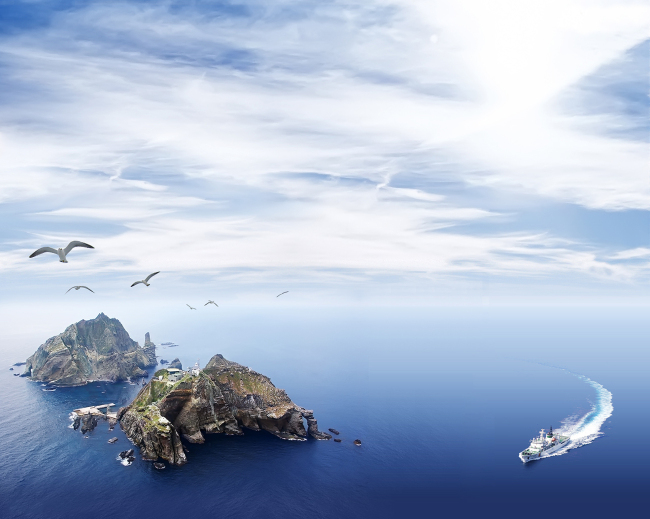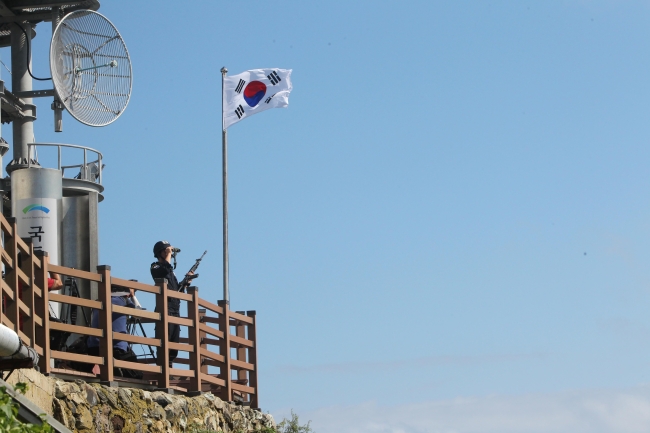Territorial tension has become more acute as both countries’ leaders attempt to use sovereignty claims and other populist policy issues as a political weapon.
The bilateral relationship suffered one of the biggest diplomatic crises in years in 2005 when Japan’s Shimane Prefecture assembly set Feb. 22 as Takeshima Day to highlight the decades-long assertion.
The move added to Japanese Prime Minister Koizumi Junichiro’s repeated trips to the controversial Yasukuni Shrine, his administration’s stipulation of Dokdo as its territory in diplomatic and defense papers, its endorsement of school textbooks whitewashing the country’s imperial past.
The chain of moves prompted then-President Roh Moo-hyun to deliver a special address, calling Tokyo’s claim “an act of negating the complete liberation and independence of Korea.”
Despite a brief letup, the ties sank to a new low after Roh’s successor Lee Myung-bak became the first Korean leader to visit Dokdo in August 2012. Then-Japanese Prime Minister Yoshihiko Noda renewed the country’s 1954 demand that the case be taken to the International Court of Justice before the U.N. General Assembly, which Seoul dismissed.
Today the dynamics surrounding the relationship are apparently growing ever more complex and multi-faceted, with Japanese Premier Shinzo Abe further stepping up the ownership argument through alongside other hawkish foreign and defense policies.
The nationalist commander-in-chief sent a vice minister-level official to the regional Takeshima Day event for the first time in February 2013. His administration installed a new office responsible for territorial sovereignty issues within the Cabinet Secretariat last year, while pushing to revise guidelines for middle and high school textbooks to describe Dokdo as Japan’s territory.
Tokyo secured 1 billion yen ($9.5 million) for territorial issue-related expenses this year, up a staggering 20 percent from a year ago. That is more than twice Seoul’s budget of 4.8 billion won ($4.5 million).
With Abe’s rightward drift unnerving neighbors, the presidents of Korea and China, Park Geun-hye and Xi Jinping, have shied away from a summit with Abe.
As they wage heated advertising campaigns, Seoul and Tokyo recently traded barbs over each other’s releases of video clips asserting their claims to Dokdo.
In its 90-second clip, Japan reiterated in nine different languages that Korea “illegally occupies” Dokdo in breach of international law. Seoul demanded that the clip be removed immediately, calling it an “anachronistic provocation.”
The increasingly bitter diplomatic row is fueling concerns that the relations may enter a vicious circle in which diplomatic brawls kindle popular anger and then spill over to eclipse economic cooperation and cultural exchanges with Japan, and derail multilateral strategic cooperation to end North Korea’s nuclear program. Experts have called on both sides to focus on basic values and work together for a more constructive partnership.
“In Japan there are not many who think the way the Abe administration does ― it merely speaks for those on the right,” said Yuji Hosaka, director of the Dokdo Research Institute at Sejong University in Seoul.
“The two countries should expand people-to-people exchanges and keep alive ministerial-level dialogue so they can resolve practical matters. Korea, meanwhile, needs to continue to consult with the U.S. and Japan, separately or altogether, to prevent its interests from being damaged by any Japanese initiative.”
Dokdo at a glance
- 87.4 kilometers southeast of Ulleungdo Island-
- 216.8 kilometers from the Korean Peninsula
- 517.5 kilometers northwest of Japan’s Okinoshima Island
- Consists of Eastern Islet, Western Islet and 89 attached rocks and reefs
- Total area: 187,554 square meters
- Eastern Islet: 73,297 square meters
- Western Islet: 88,740 square meters
- Others: 25,517 square meters
- Believed to have been formed between 4.6 million years ago and 2.5 million years ago
- Habitat for migratory fish like salmon, trout, codfish, Alaskan pollock, Pacific saury and sharks
- Home to 49 plant species, 107 bird species, 93 insect species, 160 algal species and 368 invertebrate species
- Facilities include a lighthouse, a radar base, a dock, a helicopter pad, a house for two residents, an automatic weather system, a guard post, police barracks, desalination plants and telecommunication towers
By Shin Hyon-hee (
heeshin@heraldcorp.com)
Jeong Hunny contributed to this article. --Ed.









